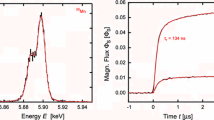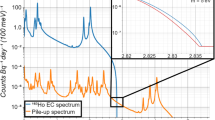Abstract
The Electron Capture in \(^{163}\)Ho experiment, ECHo, is designed to investigate the electron neutrino mass in the sub-eV range by means of the analysis of the calorimetrically measured spectrum following the electron capture (EC) in \(^{163}\)Ho. Arrays of low-temperature metallic magnetic calorimeters (MMCs), read-out by microwave SQUID multiplexing, will be used in this experiment. With a first MMC prototype having the \(^{163}\)Ho source ion-implanted into the absorber, we performed the first high energy resolution measurement of the EC spectrum, which demonstrated the feasibility of such an experiment. In addition to the technological challenges for the development of MMC arrays, which preserve the single pixel performance in terms of energy resolution and bandwidth, the success of the experiment relies on the availability of large ultra-pure \(^{163}\)Ho samples, on the precise description of the expected spectrum, and on the identification and reduction of background. We present preliminary results obtained with standard MMCs developed for soft X-ray spectroscopy, maXs-20, where the \(^{163}\)Ho ion-implantation was performed using a high-purity \(^{163}\)Ho source produced by advanced chemical and mass separation. With these measurements, we aim at determining an upper limit for the background level due to source contamination and provide a refined description of the calorimetrically measured spectrum. We discuss the plan for a medium scale experiment, ECHo-1k, in which about \(1000\,\mathrm {Bq}\) of high-purity \(^{163}\)Ho will be ion-implanted into detector arrays. With one year of measuring time, we will be able to achieve a sensitivity on the electron neutrino mass below 20 eV/c\(^2\) (90 \(\%\) C.L.), improving the present limit by more than one order of magnitude. This experiment will guide the necessary developments to reach the sub-eV sensitivity.





Similar content being viewed by others
Notes
Phase-imaging based on ion-cyclotron-resonance.
References
KATRIN, Design Report (2004), FZKA7090
A. De Rujula, M. Lusignoli, Phys. Lett. B 118, 429 (1982)
L. Gastaldo et al., in preparation (2015)
L. Gastaldo et al., J. Low Temp. Phys. 176(5–6), 876 (2014)
A. Fleischmann et al., AIP Conf. Proc. 1185, 571 (2009)
P. C.-O. Ranitzsch et al., in preparation (2015)
B. Alpert et al., Eur. Phys. J. C 75, 112 (2015). arXiv:1412.5060 [3]
NuMECS, http://p25ext.lanl.gov/~kunde/NuMECS/FSNu_Position_NUMECS_Executive
S. Eliseev et al., Phys. Rev. Lett. 115, 062501 (2015)
M. Block et al., Eur. Phys. J. D 45, 39 (2007)
F. Schneider et al., Eur. Phys. J. A 51, 89 (2015)
S. Eliseev et al., Appl. Phys. B 114, 107–128 (2014)
P.C.-O. Ranitzsch et al., J. Low Temp. Phys. 167, 1004 (2012)
R.G.H. Robertson, Phys. Rev. C 91, 035504 (2015). arXiv:1411.2906 [1]
A. Fäßler, Phys. Rev. C. 91 (2015) 045505, arXiv:1501.04338 [2]
A. Fäßler et al., Phys. Rev. C 91 (2015) 064302, arXiv:1503.0228 [2]
A. De Rúujula and M. Lusignoli (2015), arXiv:1510.05462
C. Enss. Topics in Applied Physics 99 (2005)
A. Fleischmann et al., in preparation (2015)
J.-P. Porst et al., J. Low Temp. Phys. 176, 617–623 (2014)
C. Pies et al., J. Low Temp. Phys. 167, 269 (2012)
L. Gastaldo et al., Nucl. Inst. Meth. A 711, 150 (2013)
E. Kugler, Hyperfine Interact. 129, 23 (2000)
H. Dorrer et al., in preparation (2015)
M. Maiti et al., J. Rad. Nucl. Chem. (2015)
F. Schneider et al., submitted to NIMB (2015)
C. Geppert, K. Wendt, Pramana J. Phys. 75, 1057 (2010)
J. Repp et al., Appl. Phys. B. 107, 983 (2012)
C. Roux et al., Appl. Phys. B. 107, 997 (2012)
J.A.B. Mates et al., Appl. Phys. Lett. 92(2), 023514 (2008)
S. Kempf et al., J. Low Temp. Phys. 176(3–4), 426 (2014)
P.T. Springer et al., Phys. Rev. A 35, 679 (1987)
Acknowledgments
This research was performed in the framework of the DFG Research Unit FOR 2202 “Neutrino Mass Determination by Electron Capture in \(^{163}\)Ho, ECHo” (funding under DU 1334/1-1, GA 2219/2-1, EW 299/7-1, JO 451/1-1, BL 981/5-1, EW 299/8-1) and was supported by the Max Planck Society, by the IMPRS-PTFS and by the EU (ERC Grant No. 290870-MEFUCO). H. D. acknowledges support by the Stufe 1 funding of the Johannes Gutenberg University Mainz.
Author information
Authors and Affiliations
Corresponding author
Rights and permissions
About this article
Cite this article
Hassel, C., Blaum, K., Goodacre, T.D. et al. Recent Results for the ECHo Experiment. J Low Temp Phys 184, 910–921 (2016). https://doi.org/10.1007/s10909-016-1541-9
Received:
Accepted:
Published:
Issue Date:
DOI: https://doi.org/10.1007/s10909-016-1541-9




